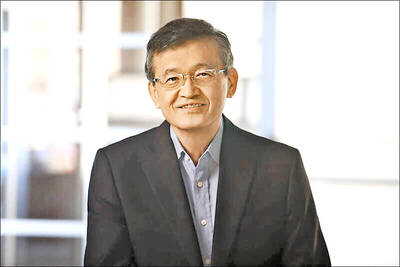An Australian man went on trial in London this week over his claims of inventing bitcoin — not the first time someone has been linked to being the cryptocurrency’s enigmatic creator.
Computer scientist Craig Wright, 53, says he is “Satoshi Nakamoto,” the pseudonym of bitcoin’s creator and author of a white paper that introduced the cryptocurrency to the world in 2008.
He is being sued by cryptocurrency activists who say he has lied and forged documents in his attempts to pretend he is bitcoin’s founder.

Photo: AFP
Bitcoin saw its popularity skyrocket to become the largest cryptocurrency, and now has a market capitalization of US$880 billion, pricing data site CoinGecko showed.
However, after collaborating with fellow developers to finesse the code, the mysterious Satoshi disappeared from the radar in about 2011. Multiple theories have since emerged regarding his identity:
Hal Finney
US developer and cryptographer Hal Finney was the first person to receive the virtual unit, when Satoshi himself sent him 10 bitcoins as a test.
However, in October last year, the theory that Finney was in fact Satoshi was discredited by a high-profile blogger in the crypto community.
The amateur sleuth said he unearthed evidence suggesting that Finney, who died in 2014, was taking part in a running race at a time when Satoshi had been answering e-mails and carrying out bitcoin transactions, thereby ruling him out.
Dorian Nakamoto
Japanese-American engineer Dorian Nakamoto was among the first to be suspected of shaking up the world of currency, following a report in 2014 by Newsweek magazine that he was behind the digital token.
“I am no longer involved in that and I cannot discuss it. It’s been turned over to other people. They are in charge of it now. I no longer have any connection,” he was quoted as saying by Newsweek.
He has since denied being Satoshi Nakamoto.
Back in 2012, bitcoin’s shadowy creator had claimed to be a 37-year-old man living in Japan, according to a profile posted online. Yet critics cast doubt on this hypothesis, citing Satoshi Nakamoto’s excellent English and typically British turns of phrase.
Nick Szabo
Szabo, a US computer scientist of Hungarian origin, was among the early adopters of decentralized cryptocurrencies and was named by a blogger in 2013 as a possible candidate to have created bitcoin.
However, industry insiders argue that there is no tangible proof that he is Satoshi, beyond circumstantial evidence.
Craig Wright
Wright has been on trial this week at London’s High Court, with proceedings expected to last until mid-March.
The enigmatic Australian programmer describes himself on X as “Creator of Bitcoin” and insists he has the required skills and knowledge to have invented it.
Crypto Open Patent Alliance (COPA), a non-profit organization set up to keep cryptocurrency technology free from patents, is suing Wright over his claims first made in 2016.
COPA accuses Wright, nicknamed “Faketoshi” by detractors, of lying about his identity and of forging and manipulating documents.
Wright has been involved in a number of lawsuits brought by himself, but this time around is being asked to defend himself.
Elon Musk
The richest man in the world has also been in the frame, after a former intern at his SpaceX company wrote a series of articles speculating that Satoshi was in fact Musk.
The ex-intern, writing on Medium Web site, claimed the billionaire uses similar language and expressions to those given by Satoshi, adding that a close colleague of Musk seemed too embarrassed to discuss it.
However, tech-savvy Musk rejected the allegations in late 2017 in the face of such meager evidence.
Uncertainty prevails
Despite feverish speculation, uncertainty reigns supreme.
Some commentators argue that a work of such scope and complexity as bitcoin could only be the work of a group of people, rather than a single developer.
Others say that it is highly likely the real Satoshi Nakamoto is either dead — or wishes to preserve the integrity of bitcoin’s collective ethos by maintaining his own anonymity.
Satoshi Nakamoto meanwhile still possesses about 980,000 bitcoins, according to industry researcher Sergio Lerner.
If the bitcoin king is alive, and decides to cash in, that could potentially crash the cryptocurrency because they are together worth about US$44 billion at current prices.

Intel Corp chief executive officer Lip-Bu Tan (陳立武) is expected to meet with Taiwanese suppliers next month in conjunction with the opening of the Computex Taipei trade show, supply chain sources said on Monday. The visit, the first for Tan to Taiwan since assuming his new post last month, would be aimed at enhancing Intel’s ties with suppliers in Taiwan as he attempts to help turn around the struggling US chipmaker, the sources said. Tan is to hold a banquet to celebrate Intel’s 40-year presence in Taiwan before Computex opens on May 20 and invite dozens of Taiwanese suppliers to exchange views

Application-specific integrated circuit designer Faraday Technology Corp (智原) yesterday said that although revenue this quarter would decline 30 percent from last quarter, it retained its full-year forecast of revenue growth of 100 percent. The company attributed the quarterly drop to a slowdown in customers’ production of chips using Faraday’s advanced packaging technology. The company is still confident about its revenue growth this year, given its strong “design-win” — or the projects it won to help customers design their chips, Faraday president Steve Wang (王國雍) told an online earnings conference. “The design-win this year is better than we expected. We believe we will win

Chizuko Kimura has become the first female sushi chef in the world to win a Michelin star, fulfilling a promise she made to her dying husband to continue his legacy. The 54-year-old Japanese chef regained the Michelin star her late husband, Shunei Kimura, won three years ago for their Sushi Shunei restaurant in Paris. For Shunei Kimura, the star was a dream come true. However, the joy was short-lived. He died from cancer just three months later in June 2022. He was 65. The following year, the restaurant in the heart of Montmartre lost its star rating. Chizuko Kimura insisted that the new star is still down

While China’s leaders use their economic and political might to fight US President Donald Trump’s trade war “to the end,” its army of social media soldiers are embarking on a more humorous campaign online. Trump’s tariff blitz has seen Washington and Beijing impose eye-watering duties on imports from the other, fanning a standoff between the economic superpowers that has sparked global recession fears and sent markets into a tailspin. Trump says his policy is a response to years of being “ripped off” by other countries and aims to bring manufacturing to the US, forcing companies to employ US workers. However, China’s online warriors